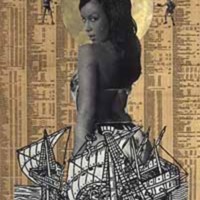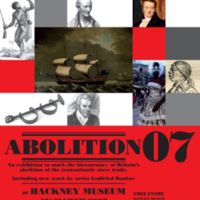
Lace and Slavery
During the Industrial Revolution Nottingham was famous for the manufacture of lace. In 2007 British-Ghanaian artist Godfried Donkor, supported by The New Art Exchange and the Centre for Contemporary Art in the city, investigated the often-neglected connections between this luxurious commodity and the cotton picked by enslaved Africans in the Caribbean and American South. The research culminated in an exhibition, ‘Once Upon a Time in the West There Was Lace’, at the Yard Gallery at Wollaton Hall in early 2008. The Elizabethan manor is also home to the Industrial Museum which holds lace-making machinery. A key part of the display were outfits created from brightly coloured lace, now a prized material in West Africa. Donkor's paintings on pages of the Financial Times represented people, culture and goods crossing the Atlantic in different eras. The exhibition was accompanied by a series of public events which looked at the links between the city’s past lace-making industry and slavery, including lectures and a free symposium.

Abolition 07
Hackney Museum's Abolition 07 exhibition told the story of British involvement in the transatlantic slave trade, the resistance to it, and its abolition, and in particular emphasised the involvement of Hackney's residents in the abolition movement. The display included new artwork by Godfried Donkor in collaboration with young Hackney artists. A film of interviews with Hackney residents, Hear My Voice, was produced. Over 1200 children from Hackney Primary Schools took part in poetry workshops at the museum with poets Adisa and Baden Prince. Their poems and responses were published in the booklet 'And Still I Rise'.
The research into Hackney's connections to the transatlantic slave trade continued in 2013-2015 with 'Local Roots / Global Routes', a collaborative project between Hackney Museum and Archives and the Legacies of British Slave-ownership project.